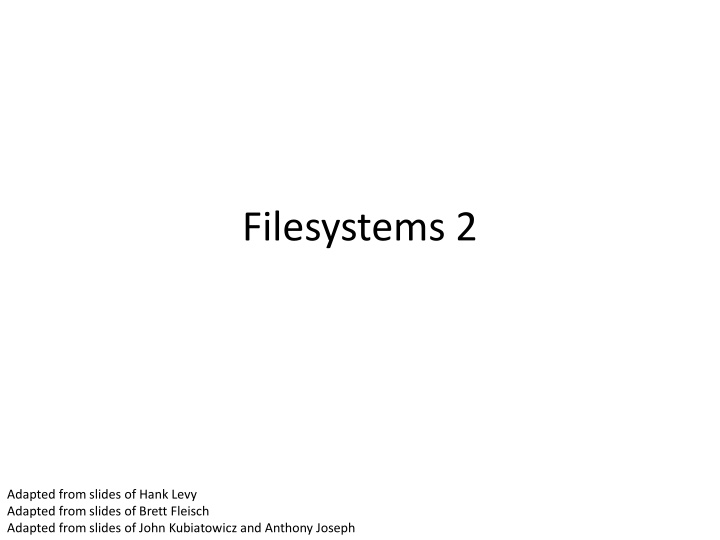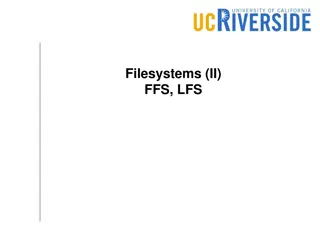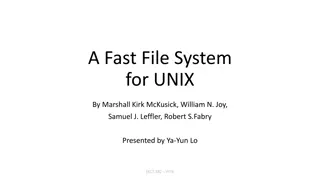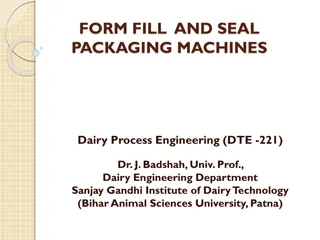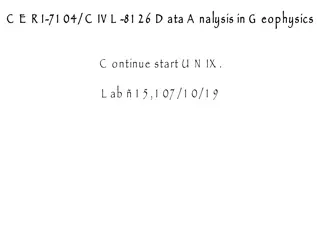Evolution of Unix Filesystems & Improvements in BSD FFS
The original Unix filesystem had limitations like small block sizes, lack of data locality, and inefficiencies in data/inode placement. To address these issues, the BSD Fast File System (FFS) was introduced in the mid-1980s, optimizing for hardware characteristics, emphasizing locality, and enhancing data/inode placement. FFS redesigned block sizes, disk layout, and inode distribution, resulting in improved file access performance and reduced seek times.
Download Presentation

Please find below an Image/Link to download the presentation.
The content on the website is provided AS IS for your information and personal use only. It may not be sold, licensed, or shared on other websites without obtaining consent from the author.If you encounter any issues during the download, it is possible that the publisher has removed the file from their server.
You are allowed to download the files provided on this website for personal or commercial use, subject to the condition that they are used lawfully. All files are the property of their respective owners.
The content on the website is provided AS IS for your information and personal use only. It may not be sold, licensed, or shared on other websites without obtaining consent from the author.
E N D
Presentation Transcript
Filesystems 2 Adapted from slides of Hank Levy Adapted from slides of Brett Fleisch Adapted from slides of John Kubiatowicz and Anthony Joseph
Unix FS shortcomings Original Unix file system (1970 s) was simple and straightforward But: Could only achieve ~20KB/sec/arm ~2% of disk bandwidth available in 1982 Issues: Small blocks 512 bytes (matched disk sector size) No locality Consecutive file blocks were placed randomly Inodes were not stored near data Inodes were stored at the beginning of the disk Data was stored at the end No read-ahead capabilities Could not pre-fetch contents of large files
Data/Inode placement Original (non-FFS) unix FS had two major problems: 1. data blocks are allocated randomly in aging file systems (using linked list) blocks for the same file allocated sequentially when FS is new as FS ages and fills, need to allocate blocks freed up when other files are deleted problem: deleted files are essentially randomly placed so, blocks for new files become scattered across the disk! 2. inodes are allocated far from blocks all inodes at beginning of disk, far from data traversing file name paths, manipulating files, directories requires going back and forth from inodes to data blocks BOTH of these generate many long seeks!
BSD Fast File System (FFS) Redesign by BSD in the mid 1980 s Main idea 1: Map design to hardware characteristics Main idea 2: Locality is important Block size set to 4096 or 8192 Disk divided into cylinder groups Laid data out according to HW architecture Replicated FS structure in each cylinder Access FS contents with drastically lower seek times Inodes were spread across disk Allowed inodes to be near file and directory data
Disk Cylinders Side effect of how rotating storage is designed Disk consists of multiple platters Data is stored on both sides of the platter Data is read by a sensor on a mechanical arm Each platter side has 1 arm Arm moves sensor to a given radius from the center and reads data as the disk spins Changing arm position is very expensive
Cylinder Group FFS developed notion of a cylinder group disk partitioned into groups of cylinders data blocks from a file all placed in same cylinder group files in same directory placed in same cylinder group inode for file in same cylinder group as file s data Introduces a free space requirement to be able to allocate according to cylinder group, the disk must have free space scattered across all cylinders Need index of free blocks/inodes within a cylinder group in FFS, 10% of the disk is reserved just for this purpose! good insight: keep disk partially free at all times! this is why it may be possible for df to report >100%
FFS locality Approaches to maintain locality: Contain a directories contents to a single cylinder group Spread directories across different cylinders Make large contiguous allocations from a single cylinder group Results Achieved 20-40% of disk bandwith for large accesses 10-20x performance improvement over Unix FS 3800 lines of code vs 2700 for Unix FS 10% of total disk space unusable First time OS designers realized they needed to care about the file system
Log Structured/Journaling File Systems Radically different file system design Motivations: Disk bandwidth scaling significantly (40% a year), but latency was not CPUs outpacing disks: I/O becoming more of a bottleneck Larger RAM capacities: file caches work well and trap most writes Problems with existing approaches Lots of small writes metadata required synchronous writes for correctness after a crash With small files, most writes are to metadata synchronous writes are very slow: cannot use scheduling to improve performance 5 disk seeks to create a file File inode (create) File data Directory entry File inode (finalize) Directory inode (modification time)
LFS basic idea Treat the entire disk as a single log for appending Coalesce all data and metadata writes into a log Single large record of all modifications Write out log to disk as a single large write operation Do not update data in place, just write a new version in the log Maintains good temporal locality on disk Good for writing Trades off on logical locality Bad for Reads Reading data means parsing the log to find the latest version But we can handle poor read performance via cache Hardware trends: Lots of available RAM Once reconstructed from the log, data can be cached in memory
LFS implementation Simple in theory, really complicated in practice collect writes in the disk buffer cache Periodically write out the entire collection of writes in one large request Log structure Each write operation consists of modified blocks Data blocks, inodes, etc Log contains data blocks first, followed by inode Basic approach to ensure consistency Write the data first, then update the metadata to activate the change Writing data takes a long time relative to metadata If system crashes during write, more likely FS will not be corrupted LFS assumes a disk of infinite size What happens when we hit the end?
Locating data How to actually find an inode without reading entire log? Solution: 1 more layer of abstraction Create a single Inode Map (imap) of all inodes in use Array of block locations Use the inode # to index into the array Every time a inode is modified, change map to point to new location in the log For performance cache map in memory But write it out at the end of every log flush to disk To find a file you just need the latest version of the imap But how to you locate the imap?
Checkpoint Region (CR) At start of disk maintain a special area that stores the location of the imap Location does not change Every time a log is flushed to disk, change the CR to point to the new imap location The CR is only updated after the log has been fully written Provides resiliency to crashes What happens if machine crashes during a log flush operation? Very small window of time for a crash to happen that would lead to inconsistent state
Garbage Collection What happens when the disk runs out of free space? Lots of data is expired (overwritten more recently) Can be discarded 1. Read in old log entries and look for expired data Expired Data = inodes that have been overwritten 2. Delete old inodes from the log 3. Write the new log to disk Expired data is removed Current data is just updated with a new location looks like a new write Space used for old log is now free
